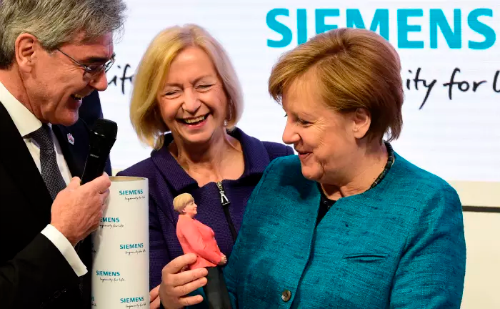Germany’s Mittelstand joins revolution in big data

Financial Times, April 27, 2017
By Patrick McGee
Amid countless rows of electronic gizmos and futuristic robotics at Hanover Fair, one machine stands apart from the rest: a wooden lathe built in 1887.
The machine resembles an antique desk, but for the foot-powered pedal that imparts motion via a spinning wheel. It has been obsolete for more than a hundred years, serving as a museum piece.
But here, at the world’s largest industry fair, Bosch, the German engineering and electronics group, has equipped it with sensors that transmit data from the machine’s every move to analytic software in a cloud.
Data collected from this old lathe form patterns and allow engineers to detect anomalies, such as a wobble in one of the machine’s moving parts or something slightly irregular. This allows them to fix the problem before it becomes terminal and leads to breakdown.
Manufacturers such as Rolls-Royce, GE and Siemens have been investing in this “predictive maintenance” technology for years. It is just one of the myriad ways they capture data across the value-chain to improve efficiencies and automate work.
The success of big companies in the so-called “industrial internet of things” has generated all kinds of buzz.
But what makes this week’s annual Hanover Fair different is the number of smaller companies — known collectively in Germany as the Mittelstand — that are involved in trying to use big data and the internet to boost productivity in what is referred to as Industry 4.0.
“The Mittelstand is waking up to Industry 4.0,” says Stefan Assmann, head of connected industry at Bosch.
If Germany is to maintain its competitive edge in industrial engineering, the Mittelstand, which forms the backbone of the country’s export-driven economy, must integrate software into their hardware, experts say.
The future for manufacturing, industry analysts add, will not be selling machines, but selling the output of the machines.
An engine, for instance, can be leased, with the user paying for its availability or uptime. This gives the manufacturer an incentive to ensure it is always running, using sophisticated software that is increasingly becoming the differentiating factor versus rivals. Businesses that choose not to be involved could face an existential risk.
Bosch’s old lathe is on display to show that for all the talk of industry “revolution”, small investments to retrofit old hardware with sensors is all that is needed to get started.
Felss, a 600-employee specialty component supplier near Stuttgart, is one company that woke up to the digital age a year and a half ago. Felss has been around since 1905 and has nearly tripled revenue since 2000, but nevertheless it felt threatened by software developments.
“As a Mittelstand you’re usually settled, your mindset doesn’t change so much,” said Wolfgang Haggenmüller, an innovation manager at Felss. “But looking at the danger of what could come from the market in the future, this could really have middle-term impact if we are not part of this.”
Felss invested in software that allows its engineers to see real-time information about machine failures and give them feedback about how to correct them. The result was efficiency gains of “up to 30 per cent”, says Mr Haggenmüller. The group is now in the process of incorporating software across its six plants.
Felss did not have the expertise to make the digital leap on its own, so it relied on Axoom, a German digital platform for manufacturers launched in 2015.
Marc Detmers, trade fair manager at Axoom, said last year “Industry 4.0” was just a buzzword at the Hanover Fair, whereas this week many small companies on his radar have concrete questions and some were giving their own presentations. “It is really ramping up,” he says.
To make the digital concepts tangible Axoom set up a café in the exhibition that provided real-time data on what customers were ordering, so it could track supplies and water usage. If too many people ordered dark roast, the right beans could be re-ordered automatically.
Omar Abbosh, chief strategy officer at Accenture, says a catalyst for the wider adoption of Industry 4.0 is that lower prices have made the technology more accessible. The cost of cloud storage in the past decade has decreased 50 times, for instance.
Developments in the car world have already previewed how big the changes can be when costs fuel an opportunity. Lidar 3D sensing technology employed by Google for self-driving car technology cost $30,000 in 2009, Mr Abbosh says.
“The automotive industry at the time said, ‘there is no way that could be commercialised because we cannot absorb that cost. By 2014, it cost $80,” he says. “So now, of course, all the major car companies are looking at autonomous vehicles.”
Business leaders acknowledge that disruption is afoot. In a survey of almost 800 companies around the world published this week, Microsoft and the Harvard Business Review found that almost half of respondents said their traditional business model “will be obsolete by 2020.”
But many are confused about what to do. Among European companies, 57 per cent of respondents — the highest of any region in the survey — said “resistance to change” was the biggest impediment to making the digital leap.
Some experts worry that German companies in particular are too complacent and risk-averse, and could prove too slow to adapt.
“A lot of the German established companies will fail,” says Roman Friedrich, managing director at the consultancy AlixPartners in Düsseldorf.
“I’m honestly and seriously concerned, because I realise how important the cultural element is to make the transition. You really need to make an effort to change the culture, by brute force. You cannot just accept this gradually.”
Mr Haggenmüller says that for Felss, a whole mindset change was needed so employees could understand the threat. “We don’t know where Industry 4.0 is going,” he says. “But we see in the commercial area that the platforms get all the money, not the hardware producers.”
Back